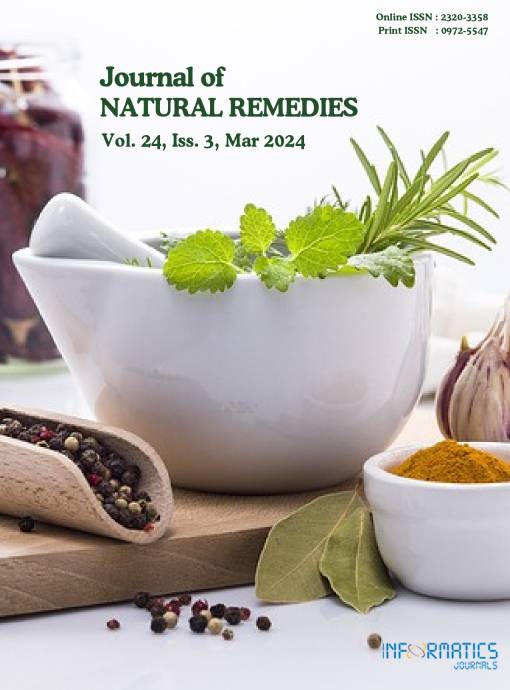Exploring the Antimicrobial Efficacy of Panchavalkala Kwatha and Arka: A Comprehensive Study
DOI:
https://doi.org/10.18311/jnr/2024/35148Keywords:
Antimicrobial Activity, Arka, Kwatha, PanchavalkalaAbstract
Panchavalkala, a combination of five tree barks, is significant in Ayurvedic formulations as an individual ingredient and in composite preparations. These five barks are Vata (Ficus bengalensis L.), Udumbara (Ficus glomerata Roxb.), Ashwatha (Ficus religiosa L.), Parisha (Thespesia populanea Soland. ex-Correa.), and Plaksha (Ficus lacor Buch-Ham.). As per Ayurveda, Panchavalkala Kwatha has vrana ropana (wound healing) properties and is also known for its diverse properties encompassing antiseptic, anti-inflammatory, antioxidant, antibacterial, and antimicrobial attributes, rendering it valuable for wound purification and healing. This study aims to investigate the antimicrobial potential of Panchavalkala Kwatha (PVK) while validating its ancient Ayurvedic significance in wound healing. The study involves meticulously preparing Panchavalkala Kwatha and Panchavalkala Arka. Panchavalkala Kwatha is meticulously prepared by the guidelines stipulated in Sharangadhara Samhita, while Panchavalkala Arka (PVA) follows the principles outlined in Arka Prakasha. The antimicrobial activity of Panchavalkala Kwatha and Panchavalkala Arka was assessed using Escherichia coli and Staphylococcus aureus through the well-diffusion assay. Panchavalkala Kwatha exhibits a substantial zone of inhibition measuring 25 mm against E. coli and 28 mm against S. aureus. This antimicrobial efficacy is comparable to Ciprofloxacin’s, signifying potent antimicrobial activity. In contrast, Panchavalkala Arka shows no inhibitory effect on microbial growth. These results underscore the robust antibacterial activity of Panchavalkala Kwatha against both E. coli and S. aureus, while Panchavalkala Arka remains inert. This research furnishes primary evidence supporting the antibacterial properties of Panchavalkala Kwatha against E. coli and S. aureus. These findings suggest the potential utility of this Ayurvedic formulation in expediting wound healing processes.
Downloads
Metrics
Downloads
Published
How to Cite
Issue
Section
License
Copyright (c) 2024 Dr Harikrishnan G, Shara Mohan, Ramesh N V, Arunmohanan, Prajeesh Nath EN (Author)

This work is licensed under a Creative Commons Attribution 4.0 International License.
Accepted 2024-01-08
Published 2024-03-27
References
Bhat K, Vishwesh BN, Sahu M, Shukla VK. A clinical study on the efficacy of Panchavalkala cream in Vrana Shodhana w.s.r to its action on microbial load and wound infection. Ayu. 2014; 35(2):135. https://doi.org/10.4103/0974-8520.146216 PMid:25558157 PMCid: PMC4279318
Srivastava S, Sharngadhara Samhita. Ch. 2. Varanasi: Chaukhambha Orientalia;. Madhayam Khand. Reprint edition. 2009. p. 135.
Ravana, Indradev Tripathy. Arkaprakasha.2nded. Varanasi: Chowkamba Sanskrit, Series, 2006. Chaturpada 34-35.
Patil V, Pimprikar R, Patil V. Pharmacognostical studies and evaluation of the anti-inflammatory activity of Ficus bengalensis Linn. Journal of Young Pharmacists. 2009; 1(1):49. https://doi.org/10.4103/0975-1483.51879
Vasudevan M, Gunnam KK, Parle M. Antinociceptive and anti-inflammatory effects of Thespesia populnea bark extract. Journal of Ethnopharmacology. 2007; 109(2):264–70. https://doi.org/10.1016/j.jep.2006.07.025 PMid:16949778
Manian R, Anusuya N, Siddhuraju P, Manian S. The antioxidant activity and free radical scavenging potential of two different solvent extracts of Camellia sinensis (L.), O. Kuntz, Ficus bengalensis L. and Ficus racemosa L. Food Chemistry. 2008; 107(3):1000–7. https://doi.org/10.1016/j.foodchem.2007.09.008
Preethi RC, Devanathan V, Loganathan M. Antimicrobial, and antioxidant efficacy of some medicinal plants against foodborne pathogens. 2010.
Sharma RK, Chatterji S, Rai DK, Mehta S, Rai PK, Singh RK, et al. Antioxidant activities and phenolic contents of the aqueous extracts of some Indian medicinal plants. Journal of Medicinal Plants Research. 2009; 3(11):944-8.
Kulkarni AM. Comparative clinical study of Panchavalkal ointment and Framycetin Sulfate cream (local application) in the management of infected wound wrt Dushta Vrana. Journal of Advanced Research in Ayurveda, Yoga, Unani, Siddha and Homeopathy. 2020; 6(3 and 4):17–24. https://doi.org/10.24321/2394.6547.201910
Dhiman K. Leucorrhoea in Ayurvedic literature review. Ayurpharm Int J Ayur Alli Sci. 2014; 3(3):73–8.
Shri Bhavamishra, Bhavaprakasha. Ch. 5. Varanasi: Chaukambha Sanskrit Bhawan; 2013. Madhya Khanda. Part II. Reprint; p. 66.
Shastri SN. Ch. 47. Varanasi: Chaukhambha Sanskrita Sansthan; 2009. Bhaishjya Ratnavali. Reprint edition; p. 819, 822.
Deepthi GB, Bhat NVG. Management of Kaphaja Yoni Vyapat by Panchavalkala Arka w.s.r to vulvovaginal candidiasis - A case report. Ayushdhara. 2021. p. 3261–9. https://doi.org/10.47070/ayushdhara.v8i3.708
Pareek A. A Study of anti-microbial activity of Panchvalkal Kwath. International Journal of Ayurveda and Pharma Research. 2022. p. 55–7. https://doi.org/10.47070/ijapr.v10i5.2380

 G. Harikrishnan
G. Harikrishnan









 0.35
0.35 24
24 0.161
0.161